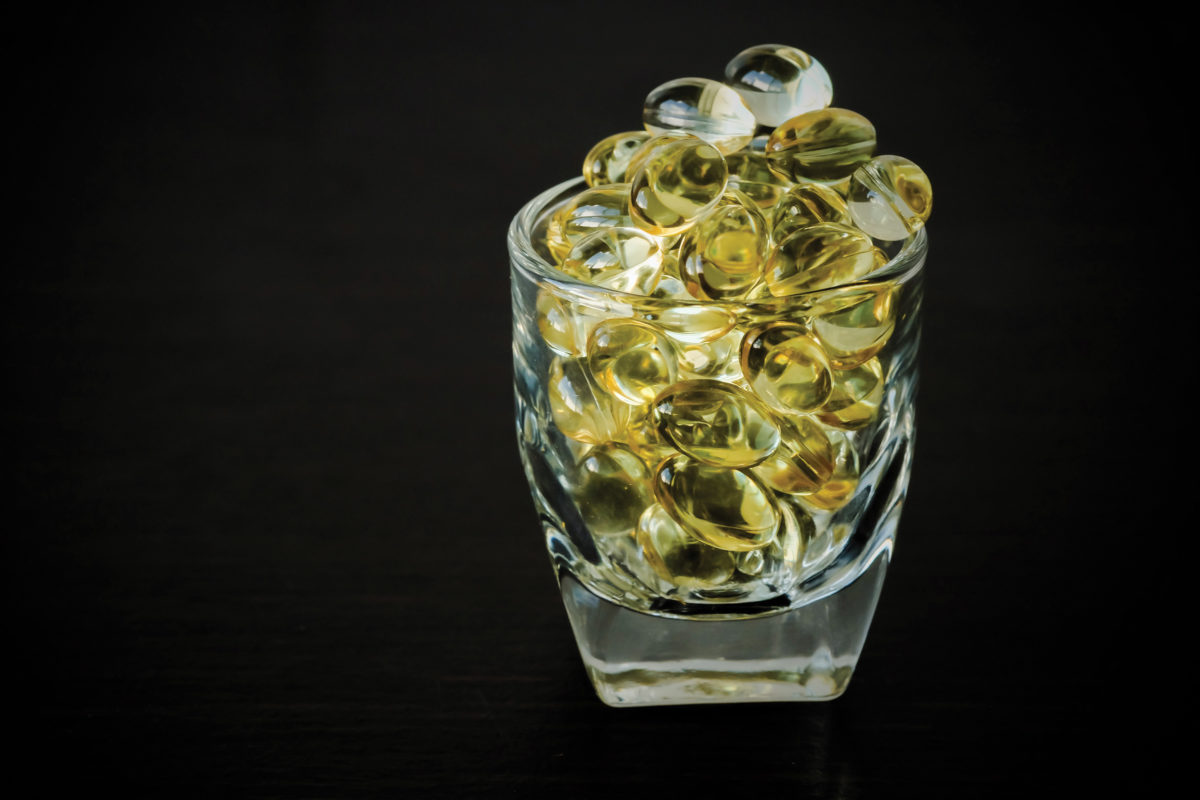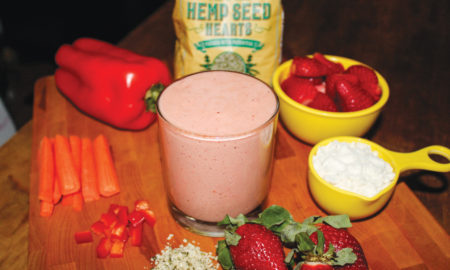

How fish oil supplements can promote growth and combat crippling muscle soreness
By George L. Redmon, PhD, ND
PQ: “These fatty acids decrease exercise-induced elevation of cortisol, known as the muscle-wasting hormone.”
“Our research demonstrates that 3,000 mg·d-1 omega-3 fatty acid supplementation minimizes the severe, delayed-onset muscle soreness that results from strenuous eccentric strength exercise. This information has obvious relevance to athletic populations but also to other groups such as physical therapy patients and newly admitted cardiac rehabilitation patients, as muscle soreness, if left unchecked, can slow the progress in adapting to a new exercise program.”
—Doisy College of Health Sciences, Department of Nutrition and Dietetics, Saint Louis University
Over the last decade, the list of products and foodstuffs that help improve muscle performance and assist individuals engaged in a variety of athletic endeavors recover more efficiently have skyrocketed. Some of those well-known products are arginine, beta-alanine, branched-chain amino acids (BCAAs), carnosine, casein protein, citrulline malate, creatine, glutamine, leucine, whey protein, as well as various antioxidants ( N-acetylcysteine-NAC, resveratrol, vitamin E, vitamin C). Despite these heavy hitters, one of the most underutilized and underpublicized recovery agents that is gaining more attention is omega-3 fatty acids. Best known for their ability to reduce the risk factors associated with heart disease, which is based on research conducted by two Danish scientists in 1978. These scientists discovered that Greenland Eskimos had less coronary heart disease than Americans, Europeans, and even present-day Japanese in spite of existing on a diet predominantly composed of fatty fish. Today, it is now a widely known fact that omega-3 fish oils comprise exceedingly high amounts of polyunsaturated fats called EPA (eicosapentaenoic acid) and DHA (docosahexaenoic acid) that play a major role in maintaining heart health. In 2002, following years of conclusive data and a mountain of established research findings, the American Heart Association released a scientific statement citing omega-3 fatty acids as being beneficial in protecting healthy individuals against heart disease, as well as those at high risk, and or those individuals already fighting this condition.
A Natural Anti-Inflammatory
Besides being transformed into hormone-like substances called prostaglandins that reduce the risk of developing heart disease, these dynamic fats are also important factors involved in proper brain development during infancy and cognitive function and its maintenance during aging. Ironically, researchers had speculated for some time that prostaglandins have an active role in reducing inflammation. Comparably, based on the ongoing research concerning the anti-inflammatory capabilities of omega-3 fatty acids and their ability to decrease the onset of various disorders (Alzheimer’s, Crohn’s disease, diabetes, inflammatory bowel disease, insulin resistance, rheumatoid arthritis, and heart disease), sports medicine researchers have found that these specific fats also have the ability to reduce the onset of exercise-induced inflammation as cited above by researchers at St Louis University. Equally, researchers from the Exercise Physiology Laboratory at Urmia University in Iran found that omega-3 fatty acids decreased muscle soreness and swelling paralleled by improvements in exercise-induced decreases in range of motion following workouts. Data indicates that these fatty acids can improve joint flexibility, reduce muscular inflammation, pain from inflammation, and accelerate recovery from exercise induced muscle damage.

Inflammatory Chemicals And Muscle Damage
Inflammation is defined as redness, swelling, pain, heat, and or the disturbed function of areas of the body. While inflammation occurs as a systemic response to injury and comes with some discomfort, it ironically is a good thing. The instant tissue, joints, or any areas within the body becomes inflamed, internal metabolic processes shift into overdrive to neutralize the toxic by-products that are generated. Comparably, when muscle damage and/or trauma to the body occurs, the body’s goal is to accelerate the repair process. However, low-grade inflammation could be compared to small smoldering fires that never go out. From a resistance-training standpoint, uncontrolled low-grade inflammation could be compared to inflamed muscle tissue that never fully recovers or heals, thus hindering the body’s efforts to promote growth. As just cited, under normal circumstances inflammation serves to notify the body that it needs to eliminate the initial cause of cell injury and clear out necrotic (dying) cells and tissues damaged from the original irritant. In essence, the inflammatory process and the signals it transmit are designed to initiate tissue repair. The fact is, physiologically the body is able to adequately neutralize normal or general inflammation. However, it is now a well-established fact that various blood markers of muscle injury—creatine kinase (CK), lactate dehydrogenase (LDH), protein carbonyls, uric acid—are elevated following a workout. When these inflammatory markers aren’t neutralized, they accumulate and not only cause muscle damage but increase oxidative stress and other cellular destructive chemicals known as free radicals or ROS (reactive oxygen species).
Omega-3s To The Rescue
Sports medicine has sought to find ways to reduce the upsurge of these inflammatory markers during workouts to enhance workload capacity and recovery. For example, investigators at the University of Aberdeen in the United Kingdom recently looked at how effective omega-3 supplementation was on exercise-induced markers of oxidative stress and muscle damage. In a recent six-week double-blind randomized placebo-controlled study, they reported that plasma thiobarbituric acid reactive substances (TBARS) were lower at 48 and 72 hours following exercise via omega-3 supplementation. As a note here, TBARS are degraded by-products of fats. They also noted that H2O2 (hydrogen peroxide) stimulated DNA damage was lower immediately following a workout in omega-3 subjects compared to controls.
Similarly, researchers of the Institute of Human Nutrition at the University of Southampton found that when subjects consumed adequate amounts of fish oils, additional inflammatory compounds as well as the expression of adhesion molecules were greatly reduced. As cited by researchers at Harvard University, adhesion molecules are sticky cell surface molecules that enable intercellular binding and communication. They essentially direct cell-to-cell interactions and are necessary for embryonic development, cell growth and differentiation (change from a generalized form to another, specialize one), pathogen detection, inflammation, and wound repairs. As alluded to by these scientist, understanding exactly how adhesion molecules work will lead to a better understanding of how to limit the signals associated with upregulating inflammation and the various disorders it causes. These researchers contributed these attributes to long-chain n-3 polyunsaturated fatty acids found in omega-3 fish oils.
Delayed Onset-Muscle Soreness
While muscle fatigue and soreness can be felt in many cases within the hour following workouts, it is the muscle soreness, lethargy, and pain that hits you like a ton of bricks and lasts for days that keeps you from your next scheduled exercise routine. Scientist refer to this mishap as DOMS, short for delayed onset muscle soreness. In a 2014 study appearing in the Journal Of Sports Science And Medicine investigators administered 2.7 grams of an omega-3 supplement for 30 days before heavy eccentric exercise to one group, with a second group receiving a placebo. The goal of this study was to determine what impact increased tissue levels of omega-3 had on healthy young adults after routine heavy eccentric exercise. They found that inflammatory markers like C-reactive protein (CRP), creatine kinase, blood lactate levels, and associated reduced levels of soreness and functionality due to DOMS where significantly reduced in the omega-3 subjects.

Beating Catabolic And Inflammatory Activity
The metabolic pathways known as mTOR and p70S6K play a key role in regulating protein synthesis (the creation of new proteins) and is upregulated by the amino acid leucine.
Researchers recently at Washington University School of Medicine found that daily doses of 1.86 grams of EPA and 1.5 grams of DHA for eight weeks heightened the activity of both of these pathways by amplifying anabolic signals that resulted in more efficient use of amino acids and insulin. As you know, insulin is the hormone that drives amino acids and nutrients into muscle cells, which is essential to muscle growth and recovery. These researchers also found an increase in both muscle protein concentration and the protein/DNA ratio or muscle cell size in the omega-3 group. Researchers now know that the metabolic pathway referred to as the ubiquitin-proteasome system is the primary place that upregulates muscle-wasting activity. Uniquely, researchers at Aston University (United Kingdom) discovered that omega 3s, specifically EPA decreased the activity of this pathway and decreased protein catabolism. As cited by researchers, agents like EPA that inhibit NF-kappaB activation are effective in the preservation of skeletal muscle mass. This dynamic aspect of omega 3s anabolic prowess is exhibited via all the related data that conclusively shows that these fatty acids decrease exercise-induced elevation of cortisol, known as the muscle-wasting hormone.
The Anabolic Nature Of Omega-3s
While omega-3 fatty acids don’t necessarily pack an anabolic punch like creatine or protein, they are intimately involved with minimizing a variety of biological catabolic or muscle-wasting protocols, mechanisms, and hormones. For example, researchers now know that supplements like arginine and citrulline have the ability to increase nitric oxide production, thus increasing blood and nutrient flow to muscles and impacting growth. To this point, researchers at the University of California reported in the European Journal Of Applied Physiology that omega-3s have the ability to also enhance blood flow to hard-working muscles during workouts. In this study, two grams of DHA plus three grams of EPA taken over a six week period revealed a substantial increase in blood flow from 293 up to 367 milliliters or 25 percent per minute, as compared to the placebo group. The scientists concluded that this was not only beneficial to healthy exercising individuals, but also to individuals who have cardiovascular problems and exercise intolerance. Additionally, in a related study, another group of researchers at the University of California found that DHA and EPA enhanced blow flow and vascular conductance via enhanced nitric oxide production. These researchers noted that this activity was upregulated in active skeletal muscle, especially type I and type IIa fibers. These researchers noted that the increase in blood flow was due to an increase in cardiac output as a result of omega-3 intake, an additional heart health attribute.
Lastly, researchers at the Yale Medical School found that sustained fish oil intake acts as a powerful regulator of adiponectin secretion. Adiponectin is the hormone created by fat cells that control the metabolism of fats. Adiponectin also effects how the body responds to insulin, (reduced insulin resistance and less fat storage) and has powerful anti-inflammatory capabilities. Emerging data indicates that day-to-day omega-3 supplementation can raise levels of this hormone by 14 to 60 percent.
Overall, omega-3 fatty acids can improve joint flexibility, reduce muscular inflammation, and pain as well as accelerate recovery from exercise induced muscle injury, while improving muscle strength, performance, and workload capacity. As cited by well-known professor of neurological surgery, Joseph C. Maroon, MD, at the University of Pittsburgh and consultant for the Pittsburgh Steelers, fish oil is nature’s safest most effective anti-inflammatory. Although underpublicized, it safely and effectively covers both your physiological muscle recovery and health maintenance needs.

















You must be logged in to post a comment Login